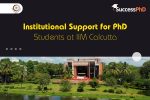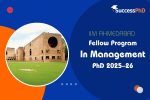Dreaming of a PhD in the USA?
From Application to Graduation – Here’s Everything You Need to Know!
Pursuing a PhD in the USA is a major academic and professional milestone. It is a long but rewarding journey that provides extensive knowledge, research experience, and opportunity to advance one’s career. The USA is home to some of the world’s top universities, offering cutting-edge research facilities, expert faculty, and diverse funding options. A PhD from a reputable university can lead to leadership opportunities in a variety of fields, industry research roles, and academic positions.
A PhD is a demanding course that usually takes up four to six years. To complete a dissertation, it entails coursework, tests, and original research. Aspiring researchers find the USA to be an appealing option because, in contrast to many other nations, PhD programs there frequently accept students straight out of bachelor’s degrees. The application procedure, however, can be difficult and requires a compelling purpose statement, research experience, and academic record.
This guide will cover everything you need to know about pursuing a PhD in the USA, including top universities, the application process, funding opportunities, job prospects, and student life. Whether you are considering an academic career or industry research, this comprehensive guide will help you make informed decisions for your future.
Why Study a PhD in the USA?
Pursuing a PhD in the USA imparts a unique academic experience that goes beyond traditional research-focused programs. American universities provide a structured and comprehensive approach to doctoral studies, emphasizing professional development, interdisciplinary collaboration, and innovation.
-
In-Depth Learning and Research Excellence
Students get a chance to build a strong foundation in their subject before fully committing to a dissertation topic. The initial years involve coursework, seminars, and research projects, helping students develop a thorough understanding of their field. This structured approach ensures that by the time they begin their independent research, they are well-prepared.
-
Top-Tier Research Institutions
The USA is home to some of the world’s most prestigious universities, many of which rank at the top of global research tables. Institutions like Harvard, MIT, Stanford, and Caltech are known for groundbreaking research, significant funding, and world-class faculty. These universities invest heavily in research infrastructure, providing students with cutting-edge resources and opportunities to contribute to innovative discoveries.
-
A Global Academic Community
American universities foster an international learning environment by accepting students from a wide range of academic and cultural backgrounds. PhD candidates can work with academics from all over the world thanks to this exposure, which expands their horizons and improves their research capacity.
-
Innovation and Career Opportunities
The USA has long been a leader in postgraduate education, pioneering new approaches to doctoral training. With a vast number of universities across different states, students can find programs tailored to their specific research interests. Moreover, strong industry collaborations and research funding opportunities increase job prospects in both academia and the corporate sector.
-
Financial Support and Scholarships
Numerous American universities offer substantial financial aid packages that include scholarships, teaching fellowships, and research assistantships. International students can now pursue their PhDs more easily and affordably thanks to this financial assistance.
Structure of a PhD in the USA
A PhD in the USA typically follows a structured path that combines coursework, exams, and research, spanning 4-6 years. Unlike many other countries, US PhD programs often admit students directly after a bachelor’s degree, incorporating a mix of learning and research.
1. Coursework (1-2 Years)
The first phase involves completing graduate-level coursework to build a strong foundation in the subject. Students take core and elective courses, participate in seminars, and work on small research projects.
2. Qualifying/Comprehensive Exams (Year 2-3)
After coursework, students must pass qualifying or comprehensive exams to demonstrate mastery of their field. These exams may be written, oral, or both and serve as a gateway to the research phase.
3. Research Proposal and Candidacy (Year 3-4)
Students start working on their dissertation proposal as soon as they pass their exams, formally becoming PhD candidates. In this phase, a research problem must be identified, literature reviews must be completed, and methodologies must be developed.
4. Dissertation Research and Defense (Year 4-6)
The final stage focuses on independent research, culminating in a dissertation. Students must defend their research findings before a committee, proving their contribution to the field.
This structured approach ensures that PhD candidates are well-prepared for academic and professional careers.
Eligibility Criteria for PhD Programs in the USA
Students must meet several academic and language requirements to become eligible for a PhD program in the USA. Each university has specific criteria, but the general eligibility conditions include:
1. Academic Qualifications
- The minimum requirement is a bachelor’s degree (four-year program). However, some programs prefer applicants with a master’s degree, especially in research-intensive fields.
- A strong GPA (Grade Point Average) is important. Most top universities expect a GPA of 3.0 or higher on a 4.0 scale.
2. Standardized Tests
- The GRE (Graduate Record Examination) is required for many PhD programs, though some universities have waived this requirement in recent years.
- International students must take TOEFL (Test of English as a Foreign Language) or IELTS (International English Language Testing System) to prove English proficiency. A TOEFL score of 90+ or an IELTS score of 6.5+ is generally required.
3. Research Experience
- Prior research work, publications, or a strong research proposal strengthens the application.
- Some programs require students to contact potential advisors before applying.
4. Letters of Recommendation and Statement of Purpose
- Applicants must submit 2-3 letters of recommendation from professors or professionals.
- A statement of purpose (SOP) explaining research interests and career goals is essential.
5. Work Experience (Optional)
- Some programs, especially in business and engineering, prefer applicants with relevant work experience.
Cost of Pursuing a PhD in the USA
Depending on the university, field of study, and residency status of the student, the cost of pursuing a PhD in the USA varies greatly. Private and public schools charge different tuition, and international students typically pay more.
- Public universities: Particularly for in-state students, these establishments have reduced tuition costs. Public university PhD programs typically cost $12,737 annually, but for international students, the cost can occasionally reach $20,000 or more.
- Private Universities: The average annual tuition for a PhD program at these universities is $43,300. Private universities, in contrast to public ones, charge both domestic and foreign students the same tuition.
Apart from tuition, PhD students need to consider additional expenses such as living costs, health insurance, books, and research materials. The cost of living varies by location—cities like New York, Boston, and San Francisco are expensive, while smaller towns are more affordable.
Fortunately, many PhD students receive funding through fellowships, research assistantships, and teaching assistantships, which cover tuition and provide a stipend for living expenses. Some universities also offer scholarships and external grants to support students financially.
With proper funding and financial planning, pursuing a PhD in the USA can be affordable and rewarding for students dedicated to research and academic excellence.
PhD Application Process in the USA
Applying for a PhD in the USA involves several steps. Here’s a step-by-step guide:
1. Research and Choose a Program
- Identify universities offering PhD programs in your field.
- Look at faculty research interests and available funding.
- Check program requirements and deadlines.
2. Meet the Eligibility Criteria
- A master’s degree is not always required; many programs accept students directly after a bachelor’s degree.
- A strong academic record (GPA requirement varies by university).
- Research experience and publications (if possible).
3. Take Standardized Tests
- GRE (Graduate Record Examination) – Some programs require this; check university requirements.
- TOEFL/IELTS – Required for international students to prove English proficiency.
4. Prepare Application Documents
- A personal essay outlining your research interests, objectives, and reasons for wanting to enroll in the program is called a Statement of Purpose (SOP).
- Recommendation letters are typically two to three letters from academics or experts who are familiar with your work.
- Academic accomplishments, research experience, and publications should all be included in the resume or CV.
- Writing samples are frequently used in the social sciences and humanities, if necessary.
5. Apply Online
- Most universities have an online application system.
- Pay the application fee (varies from $50 to $150 per university).
6. Attend Interviews (If Required)
- Some programs conduct interviews (via Zoom or in person) to assess your research potential.
7. Receive Admission Decision
- Decisions usually come between January and April.
- If accepted, you will receive an offer letter with funding details.
Scholarships and Funding
PhD students in the USA often receive funding through:
1. University Fellowships
- Many universities offer fellowships covering tuition and a stipend.
- Example: Fulbright Scholarship, Knight-Hennessy Scholarship (Stanford).
2. Teaching and Research Assistantships
- Students work as teaching assistants (TAs) or research assistants (RAs) in exchange for a stipend and tuition waiver.
3. Government and Private Scholarships
- National Science Foundation (NSF) Graduate Research Fellowship.
- Gates Cambridge Scholarship (for international students in partnership programs).
- AAUW International Fellowships (for women in doctoral programs).
4. External Grants
- Many organizations offer grants for research and conferences.
Job Opportunities After a PhD in the USA
Earning a PhD in the USA opens a wide range of career opportunities across academia, industry, government, and entrepreneurship. Depending on the field of study and expertise, graduates can pursue rewarding roles in various sectors.
1. Academic Careers
- Professor: Many PhD graduates aim for faculty positions at universities, where they teach, conduct research, publish papers, and mentor students.
- Postdoctoral Researcher: Before securing a tenure-track position, many graduates gain additional research experience as postdoctoral fellows at universities or research institutions.
2. Industry Jobs
- Research Scientist: Many PhD holders work on cutting-edge inventions in engineering, technology, and pharmaceutical companies.
- Data Scientist: PhD holders in computer science, economics, and engineering who possess proficiency in statistics and analytics are in great demand in the fields of artificial intelligence, finance, and business.
- Consultant: Using their problem-solving abilities in top companies, many PhD holders go on to work in management consulting, market research, or financial analysis.
3. Government and Policy Roles
- Scientific Advisor: The US government, research organizations, and regulatory bodies hire PhD experts to guide policies in healthcare, technology, and energy.
- Policy Analyst: PhD graduates help shape public policies by working in think tanks, NGOs, and federal agencies like the National Institutes of Health (NIH) and NASA.
4. Entrepreneurship
- Many PhD holders launch startups in biotechnology, AI, and education, using their research for innovation.
With its strong research ecosystem and thriving job market, the USA offers excellent career prospects for PhD graduates.
Conclusion
The complex selection process and strict screening makes a PhD from USA all the more sought after. It is a challenging yet rewarding journey that requires dedication, patience, and strategic planning. With world-renowned universities, advanced research facilities, and various funding opportunities, the USA remains a top destination for doctoral studies.
While tuition costs can be high, many students receive funding through fellowships, assistantships, and scholarships. Proper financial planning can ease the burden. Career opportunities after a PhD are diverse. Graduates can pursue academic roles as professors or researchers, work in industries like technology, healthcare, and finance, or contribute to government and policy research. Some even become entrepreneurs or consultants.
In conclusion, a PhD in the USA offers immense growth potential. With careful preparation and a strong research focus, students can unlock exciting career opportunities and make meaningful contributions to their fields.








Comments